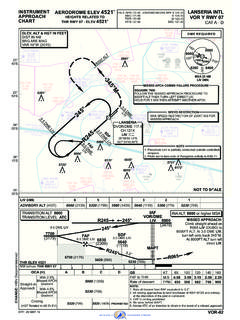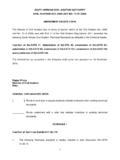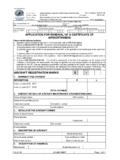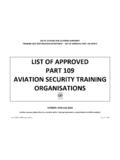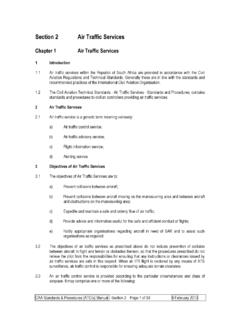Transcription of Category I (CAT I) operation” means a precision …
1 Category I ( cat i ) operation means a precision instrument approach and landing with a decision height not lower than 200 feet (60 meters) and with either a visibility of not less than 800 meters or a RVR of not less than 550 meters; Category II (CAT II) operation means a precision instrument approach and landing with a decision height lower than 200 feet (60 meters) but not lower than 100 feet (30 meters) and a RVR of not less than 350 meters; Category IIIA (CAT IIIA) operation means a precision instrument approach and landing with a decision height lower than 100 feet (30 meters) or no decision height, and a RVR of not less than 200 meters; Category IIIB (CAT IIIB) operation means a precision instrument approach and landing with a decision height lower than 50 feet (15 meters) or no decision height, and a RVR of less than 200 meters but not less than 50 meters; Category IIIC (CAT IIIC) operation means a precision instrument approach and landing with no decision height and no RVR limitations; Class A GNSS equipment means GNSS equipment incorporating both the GNSS sensor and navigation capability, including RAIM: (a) Class A1 en-route, terminal and non- precision approach other than localiser, navigation capability; (b) Class A2 en-route and terminal navigation capability only.
2 Class B GNSS equipment means GNSS equipment consisting of a GNSS sensor, which provides data to an integrated navigation system: (a) Class B1 en-route, terminal and non- precision approach , other than localiser, navigation capability; (b) Class B2 en-route, and terminal navigation capability only, providing RAIM; (c)Class B3 en-route, terminal and non- precision approach , other than localiser, which equipment requires the integrated navigation system to provide a level of GPS integrity equivalent to that provided by RAIM; (d) Class B4 en-route and terminal navigation capability only, which equipment requires the integrated navigation system to provide a level of GPS integrity equivalent to that provided by RAIM; Class C GNSS equipment means GNSS equipment consisting of a GNSS sensor that provides data to an integrated navigation system that in turn provides guidance to an autopilot or flight director in order to reduce Flight Technical Error (FTE): (a) Class C1 en-route, terminal and non- precision approach , other than localiser, navigation capability, providing RAIM; (b) Class C2 en-route and terminal navigation capability only, providing RAIM; (c) Class C3 en -route, terminal and non- precision approach , other than localiser, which equipment requires the integrated navigation system to provide a level of GPS integrity equivalent to that provided by RAIM.
3 (d) Class C4 en-route and terminal capability only, which equipment requires the integrated navigation system to provide a level of GPS integrity equivalent to that provided by RAIM; cloudbreak/breakcloud procedure means a series of predetermined manoeuvres by reference to flight instruments with specified protection from obstacles from the initial approach fix, to a point at which visual contact with the surface may be made and from which a landing or circling approach can be completed and thereafter, if a landing is not completed, to a position at which holding or en-route obstacle criteria apply; competency means a combination of skills, knowledge and attitudes required to perform a task to the prescribed standard; continuity in relation to GNSS refers to the capability of the total system, comprising all elements necessary to maintain aircraft position within the defined airspace, to perform its function without non-scheduled interruptions during the intended operation; accuracy in relation to GNSS, refers to the degree of conformance between the estimated, measured, or desired position or velocity of a system at a given time and its true position or velocity, usually presented as a statistical measure of system error, and is specified as predictable, repeatable and relative; availability in relation to GNSS refers to an indication of the ability of the system to provide usable service within the specified coverage area and is defined as the portion of time during which (a) the system is to be used for navigation.
4 And (b) reliable navigation information is presented to the flight crew, autopilot or other system managing the flight of the aircraft; decision altitude/height means a specified altitude or height in a precision approach or approach with vertical guidance at which a missed approach shall be initiated if the required visual reference to continue the approach has not been established; finding means a conclusion by the operator s audit personnel that demonstrates nonconformity with a specific standard; precision approach means an instrument approach for landing in which precision azimuth guidance and precision glide path guidance are provided in accordance with the minima prescribed for the Category of operation. radio navigation service means a service providing guidance information or position data for the efficient and safe operation of aircraft supported by one or more radio navigational aids; radio site means a site for the location of communication, navigation, surveillance or meteorological ground equipment, or a collection thereof, for the purpose of aviation safety; radiotelephony means a form of radio communication primarily intended for the exchange of information in the form of speech; RAIM warning refers to a warning that the integrity of the navigation position solution derived from GNSS satellites signals may be unreliable; surveillance system means a generic term referring to ADS-B, PSR, SSR or any comparable ground based system that enables the identification of aircraft.
5 Airborne collision avoidance system means an aircraft system based on secondary surveillance radar (SSR) transponder signals that operates independently of ground-based equipment to provide advice to the pilot on potential conflicting aircraft that are equipped with SSR transponders by issuing either a traffic alert, a traffic advisory or a traffic resolution; air navigation infrastructure means infrastructure including air navigation, communication and surveillance aids and air traffic control systems, provided for the movement of air traffic and where applicable, any building or structure on or to which such infrastructure or part thereof is housed or attached, and includes the premises on which such infrastructure or part thereof is situated, whether these be situated inside an aerodrome or elsewhere; approved maintenance schedule means a document compiled by an owner or operator in accordance with the provisions of these Regulations, and approved by the Director in terms of regulation of Part 43, that prescribes in detail the inspections that need to be carried out in respect of an aircraft, its components, installed systems and equipment, and the intervals between such inspections; area navigation means a method of navigation which permits aircraft operation on any desired flight path within the coverage of ground or space based navigation aids or within the limits of the capability of self contained aids, or a combination of these; Note Area navigation includes performance-based navigation as well as other operations that do not meet the definition of performance-based navigation.
6 ATS frequency means an electronic radio frequency within the aviation frequency band used for the transmission and receipt of communication, navigation and surveillance data signals or voice communication; ATS facility means an, ATSU, tower, centre or any part of the communication; navigation or surveillance infrastructure set up for the provision of air traffic and associated services; ATS surveillance service means a service provided directly by means of an ATS surveillance system; ATS surveillance system is a generic term referring to ADS-B, PSR, SSR or any comparable ground-based system that enables the identification of aircraft; automatic dependent surveillance broadcast is the means by which aircraft, aerodrome vehicles and other objects can automatically transmit and/or receive data such as identification, position and additional data, as appropriate, in a broadcast mode via a data link; BARO VNAV system refers to a non- precision navigation system that presents computed vertical guidance to the pilot, associated to a specified Vertical Path Angle (VPA), nominally three degrees (3 ), which is referenced to barometric altitude and which is specified as a VPA from a Reference Datum Height (RDH).
7 Class C GNSS equipment means GNSS equipment consisting of a GNSS sensor that provides data to an integrated navigation system that in turn provides guidance to an autopilot or flight director in order to reduce Flight Technical Error (FTE): (a) Class C1 en-route, terminal and non- precision approach , other than localiser, navigation capability, providing RAIM; (b) Class C2 en-route and terminal navigation capability only, providing RAIM; (c) Class C3 en -route, terminal and non- precision approach , other than localiser, which equipment requires the integrated navigation system to provide a level of GPS integrity equivalent to that provided by RAIM; (d) Class C4 en-route and terminal capability only, which equipment requires the integrated navigation system to provide a level of GPS integrity equivalent to that provided by RAIM; controller-pilot data link communications means a means of communication between controller and pilot, using data link for ATC communications; GNSS means a worldwide position and time determination system that includes one or more satellite constellations, aircraft receivers and system integrity monitoring, augmented as necessary to support the RNP for the intended operation.
8 GNSS incident refers to an incident involving but not limited to, the malfunctioning of equipment, signals or human performance in the operation of a GNSS system; GNSS sensor refers to a single GNSS unit used for navigation within a flight management system; integrity in relation to GNSS, refers to the ability of a system to provide timely warnings to users when the system performance has exceeded predetermined safe limitations and should not be used for navigation; lateral navigation refers to azimuth navigation without positive vertical guidance associated with non- precision approach procedures or en-route; nautical mile means the length equal to 1 852 metres exactly; navigation specification means a set of aircraft and flight crew requirements needed to support performance-based navigation operations within a defined airspace.
9 There are two kinds of navigation specifications (a) RNP specification. A navigation specification based on RNAV that includes the requirement for performance monitoring and alerting, designated by the prefix RNP, RNP 4, RNP APCH; and (b) RNAV specification. A navigation specification based on RNAV that does not include the requirement for performance monitoring and alerting, designated by the prefix RNAV, RNAV 5, RNAV 1; non precision approach and landing means an instrument approach and landing operation that utilises lateral guidance but does not utilise vertical guidance; Notice to Airmen means a notice containing information concerning the establishment,condition or change in any aeronautical facility, service, procedure or hazard, the timely knowledge of which is essential to personnel concerned with flight operations , distributed by means of telecommunication by or with the authority of the Director.
10 Performance based navigation means area navigation based on performance requirements for aircraft operating along an ATS route, on an instrument approach procedure or in a designated airspace; Note Performance requirements are expressed in navigation specifications in terms of accuracy, integrity, continuity, availability and functionality needed for the proposed operation in the context of a particular airspace concept. precision approach means an instrument approach for landing in which precision azimuth guidance and precision glide path guidance are provided in accordance with the minima prescribed for the Category of operation. precision approaches are categorized as follows radio navigation service means a service providing guidance information or position data for the efficient and safe operation


